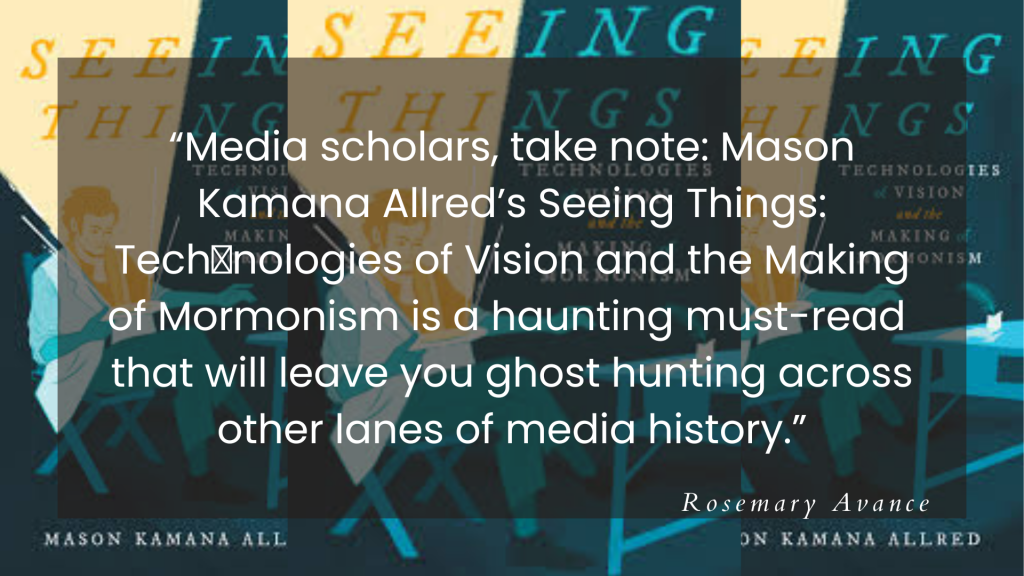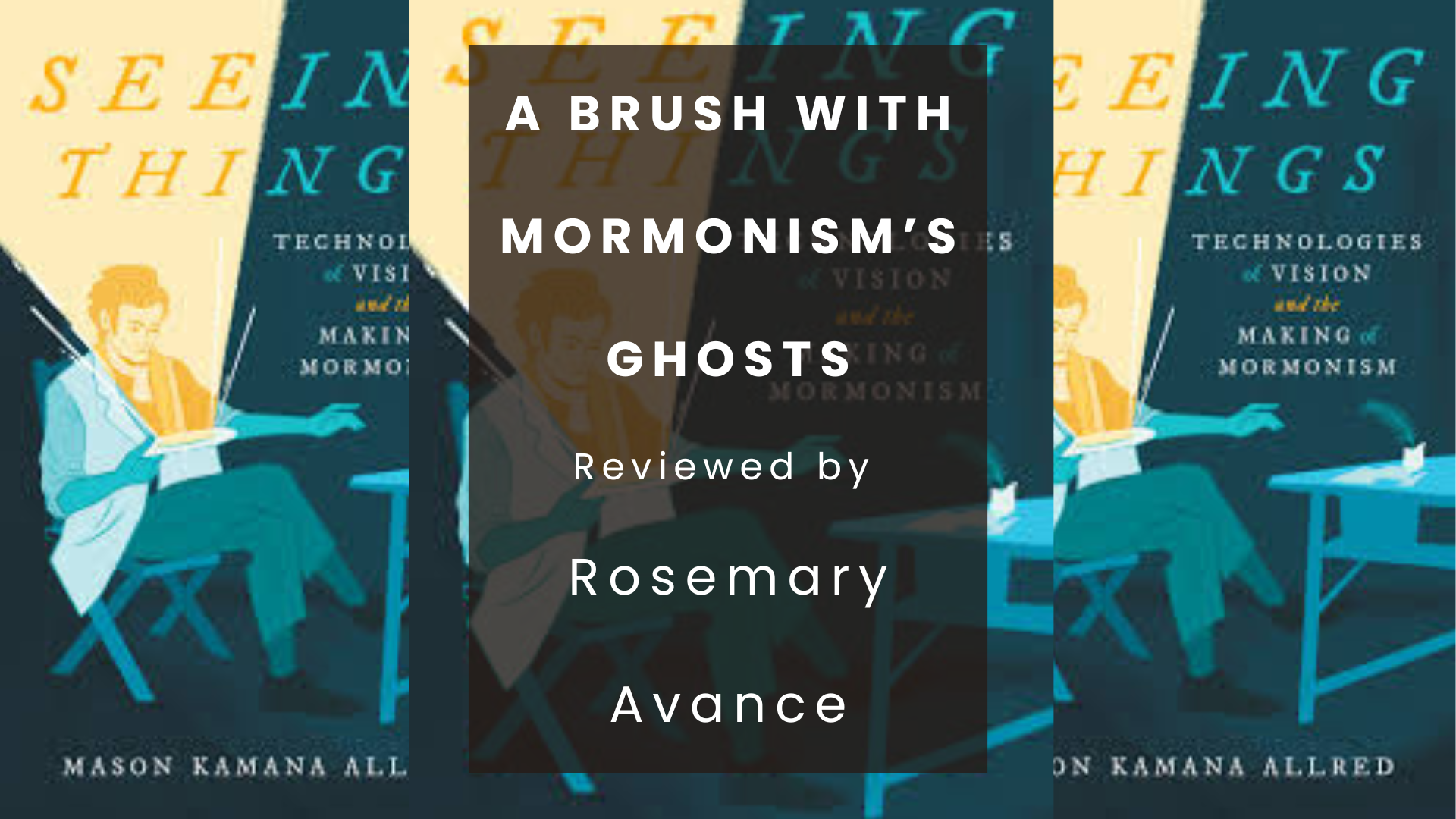Articles/Essays – Volume 58, No. 1
A Brush with Mormonism’s Ghosts | Mason Kamana Allred, Seeing Things: Technologies of Vision and the Making of Mormonism
Media scholars, take note: Mason Kamana Allred’s Seeing Things: Technologies of Vision and the Making of Mormonism is a haunting must-read that will leave you ghost hunting across other lanes of media history.
After pointing to Ben and John Durham Peters’s 2018 assertion that “Mormonism is a media religion” in the introduction, the rest of Allred’s text provides painstaking evidence for the claim. But Seeing Things does what other book-length Mormon media histories have not yet done: It weaves Mormon history, cosmology, and material culture tightly with the history of media technologies to reinforce a broader theoretical framework for understanding Mormonism as uniquely embodied—and all of that through his deft application of an incisive thematic device: “Mormons using machines to manage ghosts” (16).
Allred uses tightly focused case studies to investigate how Mormons have interpreted and engaged with a shared reality through the lens of various screen technologies, including print, canvas, glass plates in magic lanterns, type, film, microfilm, and television. Calling these “technologies of vision,” Allred argues that Mormon ways of seeing derive from their use of these devices to reproduce experience and, in that way, invent tradition. For Allred, the First Vision casts long, ghostly shadows across Mormon history; Mormonism is a “culture of seeing” preoccupied with managing the religious philosophers’ dilemma of body and spirit duality.

Allred’s approach blends material culture and media history in a style reminiscent of Russ Castronovo’s 2004 book, Necro Citizenship: Death, Eroticism, and the Public Sphere in the Nineteenth-Century United States. While Castronovo is interested in the shaping of a post–Civil War political sphere and Allred in the making of a world religion, it is no coincidence that both authors focus heavily on themes emerging from nineteenth-century American Spiritualism, which set the stage for the Mormon struggle with the spectral.
The book is structured into six chapters, with an additional introduction and conclusion. Chapter 1, “Circulating Specters,” examines the presence of ghosts in Joseph Smith’s cosmology and their ensuing haunting of Mormon lore. Beginning with phantasmagoria shows, in which glass slides were illuminated through a lantern to project an image, Allred traces technologies from Smith’s lifetime that helped him and his fellow founders concretize and replicate the specters at the center of Mormonism, from the more obvious Angel Moroni to the Book of Mormon, itself a ghost text concretized through technologies of seeing.
Chapter 2, “Panoramic Visions,” presents the place of Philo Dibble’s panoramic art in memorializing Smith after his passing, and thus standardizing a vision of him as a spirit and a body. Later panoramic painters continued the tradition, codifying Mormon oral histories into epic narratives meant to be read sequentially as a story about the past and future of the faith and thus to “bring viewers to the same vision” of Mormonism-as-history.
Chapters 3 and 4 interpret the materiality of media representation vis-à-vis gender and race. In chapter 3, “Sensitive Machines,” Allred focuses on depictions of and by Mormon women through photography and typewriting. All of these topics are deeply familiar to me, but Allred’s parallels between nineteenth-century Mormonism’s gender ordering that depicted women as vessels for the birthing of spirits and nineteenth-century America’s gendered ordering that depicted women as vessels for the birthing of men’s ideas through transcription—that is, both vessels of mechanical reproduction for men’s seed—left me rereading this chapter. His treatment of women’s creativity in transcription roles mirrors the political resistance among some Spiritualist mediums; see Castronovo’s chapter 3, “‘That Half-Living Corpse’: Female Mediums, Séances, and the Occult Public Sphere.”
In Chapter 4, “Cinematic Traffic,” Allred is interested in the LDS Church’s use of film to both standardize and visualize Mormonism for a curious and skeptical public. Examining One Hundred Years of Mormonism, a now-lost film from 1913, Allred shows the evolution of Mormon preoccupation with public image, curating a view of the faith as all-American and unmistakably white.
Chapter 5, “Micromanaging Death,” deals with post-WWII Mormon obsession with proxy baptism and the Church’s pioneering use of microfilm and microphotography to catalog enormous troves of resulting records. Allred shows the dually haunted nature of proxy work by juxtaposing the spiritual promptings and communions often reported by temple workers with the ghostly catalogues themselves.
Chapter 6, “Broadcasting Standards,” places Mormon Correlation, the Red Scare, and the proliferation of broadcast media in conversation to show how Mormon standards for morality and the National Television System Committee’s broadcast standards coalesced into a vision of Mormonism as patriotic, family-oriented, and godly.
Despite each chapter’s tight focus on particular technologies across time, the theme of Mormon adaptation to and use of technologies of vision reinforces a view of Mormon history as haunted. Traces of these historical ghosts are present in what is reenvisioned through media, as well as what is forgotten and ignored. While Allred does not take up new media technologies beyond a nod, he reminds us to consider the spiritual implications of technological uptake—a timely message for today’s media Mormons.
Mason Kamana Allred. Seeing Things: Technologies of Vision and the Making of Mormonism. Chapel Hill: University of North Carolina Press, 2023. 266 pp. Paper: $29.95. ISBN: 978-1-4696-7258-8.


 Back to full Issue
Back to full Issue

